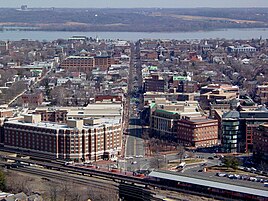Northern Virginia | |
|---|---|
Region | |
Clockwise from the top left: Tysons station entrance on the Metro Silver Line, The Pentagon, Reston and the Dulles Toll Road, Old Town Alexandria, Mount Vernon | |
| Nickname(s): NOVA, NoVA, Nova | |
 The counties of Virginia that form part of the Washington–Baltimore combined statistical area | |
| Country | |
| State | |
| Counties and independent cities | Alexandria, Arlington County, Clarke County, Culpeper County, Fairfax, Fairfax County, Falls Church, Fauquier County, Frederick County, Fredericksburg, Loudoun County, Manassas, Manassas Park, Orange County, Prince William County, Rappahannock County, Spotsylvania County, Stafford County, Warren County, Winchester |
| Largest city | Alexandria |
| Area | |
| • Land | 11,425.6 km2 (4,411.45 sq mi) |
| 13 counties and 7 independent cities in Virginia within the Washington Metropolitan Statistical Area or Washington-Baltimore Combined Statistical Area | |
| Population (2023) | 3,257,133 |
| • Density | 285.07/km2 (738.34/sq mi) |
| Demonym | Northern Virginian |
Northern Virginia, locally referred to as NOVA or NoVA, comprises several counties and independent cities in the Commonwealth of Virginia in the United States. The region radiates westward and southward from Washington, D.C., the nation's capital, and has a population of 3,257,133 people as of 2023 U.S. Census Bureau estimates, representing over a third of the state's total population. It is the most populous region in both Virginia and the regional Washington metropolitan area.[2][3][4]
Communities in the region form the Virginia portion of the Washington metropolitan area and the larger Washington–Baltimore metropolitan area. Northern Virginia has a significantly larger job base than either Washington, D.C. or the Maryland portion of its suburbs,[5] and is the highest-income region of Virginia, with several of the highest-income counties in the nation, including three of the ten highest counties for median household income, according to the 2019 American Community Survey.[6]
Northern Virginia's transportation infrastructure includes two major airports, Ronald Reagan Washington National and Dulles International Airport, several lines of the Washington Metro subway system, the Virginia Railway Express suburban commuter rail system, transit bus services, bicycle sharing and bicycle lanes and trails, and an extensive network of Interstate highways and expressways.
The Pentagon, the headquarters of the U.S. Department of Defense and the world's second-largest office, is located in Arlington County in Northern Virginia. Northern Virginia also houses the George Bush Center for Intelligence, the headquarters for the Central Intelligence Agency in Langley, the United States Patent and Trademark Office in Alexandria, and several large companies, including several major aerospace manufacturing, consulting firms, and defense industry, which serve it and other components of the U.S. federal government.
Tourist attractions in Northern Virginia include various memorials, museums, and Colonial and Civil War–era sites, including Arlington National Cemetery, Fredericksburg and Spotsylvania National Military Park, Manassas National Battlefield Park, Mount Vernon, the National Museum of the Marine Corps, the National Museum of the United States Army, the Udvar-Hazy Center of the National Air and Space Museum, and the United States Marine Corps War Memorial. Other attractions include portions of the Appalachian Trail, Great Falls Park, Old Town Alexandria, Prince William Forest Park, and portions of Shenandoah National Park.
- ^ 13 counties and seven independent cities within the Washington MSA or Washington-Baltimore CSA
- ^ Annual Estimates of the Resident Population: April 1, 2010 to July 1, 2017, U.S. Census Bureau, Population Division (Report). Washington: U.S. Census Bureau. Retrieved March 29, 2020.[dead link]
- ^ "Demographics". Weldon Cooper Center for Public Service. Charlottesville: University of Virginia. Archived from the original on April 3, 2019. Retrieved March 16, 2019.
- ^ "American FactFinder". Archived from the original on June 25, 2009. Retrieved March 26, 2008.
- ^ Gregg, Aaron (August 19, 2016). "D.C. suburbs becoming one of the country's fastest-growing employment hubs". The Washington Post. Washington. Archived from the original on August 26, 2016. Retrieved August 28, 2016.
- ^ "America's Richest Counties". Forbes.com. January 22, 2008. Archived from the original on May 13, 2009. Retrieved February 8, 2008.




